HP Elite Dragonfly vs. Spectre x360 13: A Quick Comparison
- Paul Thurrott
- Dec 16, 2019
-
23

HP’s incredible Elite Dragonfly and Spectre x360 13 have a lot in common, but they also differ in some very important ways. Here’s a quick comparison if you’re considering buying either, which is certainly understandable.
First, the basics. Both are thin and light 13-inch premium x360 PCs, meaning that they each feature a 360-degree hinge that supports four usage modes. Both have been radically made smaller through a reduction in their depth, from front to back, resulting in shorter wrist rests (and smaller touchpads) and, in the display lid, much smaller top and bottom display bezels.
Windows Intelligence In Your Inbox
Sign up for our new free newsletter to get three time-saving tips each Friday — and get free copies of Paul Thurrott's Windows 11 and Windows 10 Field Guides (normally $9.99) as a special welcome gift!
"*" indicates required fields

In fact, the form factors are so similar, I’d assumed they were essentially identical internally, at least at some level. But HP tells me that’s not the case. They do share a few components, most notably the display hinges, but they are different platforms.

The Dragonfly owes its design to the EliteBook lineup of premium business notebooks. Its most obvious influence, of course, is the similarly-sized EliteBook 1030. But where that system weighed in at 2.76 pounds, the Dragonfly weights just 2.18 or 2.4 pounds, depending on battery configuration. The resulting weight difference(s) are due to the Dragonfly’s smaller size and, more notably, its use of magnesium rather than aluminum.
The Spectre, meanwhile, soldiers on with aluminum, which is heavier. How much heavier? It weighs in at 2.88 pounds, even more than the EliteBook 1030. Now, to be fair, any PC with a 13.3-inch display that weighs under 3 pounds is, by definition, lightweight. But this difference is part of the magic of the Dragonfly. When you pick up the lighter 2.18-pound version, in particular, it’s so light that it feels like an empty shell.
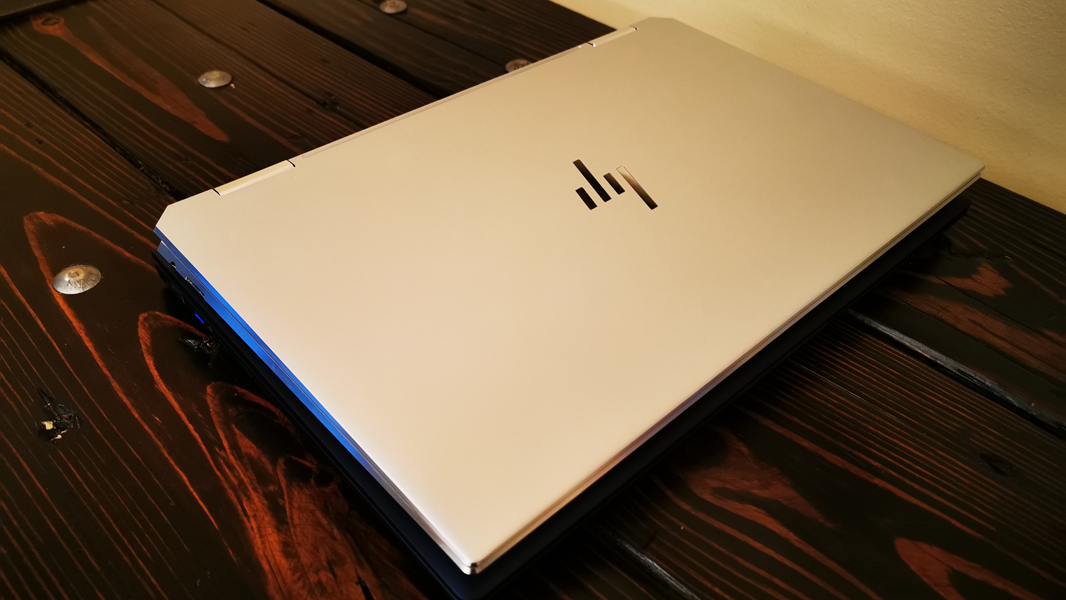
Visually, the two PCs differ quite a bit as well. The Dragonfly comes in what HP calls an “iridescent dragonfly blue finish” that I happen to find attractive. But it’s also the only color option, and if you’re not as taken with it as I am, that could be a negative. By comparison, the Spectre is available in three color options: Nightfall Black with Copper luxe accents, Poseidon Blue with Pale Brass accents, and Natural Silver. That latter option is back this year thanks to popular demand, HP says.
But the color choices, curiously, are not the biggest visual difference between the two. Where the Dragonfly provides a handsome if traditional look and feel with “diamond-cut” accents, the Spectre has a more controversial, hard-edged and very angular “gem-cut” design. Some will hate it—it’s grown on me over time—but the angular design also has a pragmatic rationale, too: Thanks to the 45-degree angle found on the back corners of the keyboard deck, HP has been able to provide unique places for both a power button (on the left) and a USB-C port (on the right), the latter of which ensures that the power cable (or any other cable) is angled to ensure it’s out of the way.
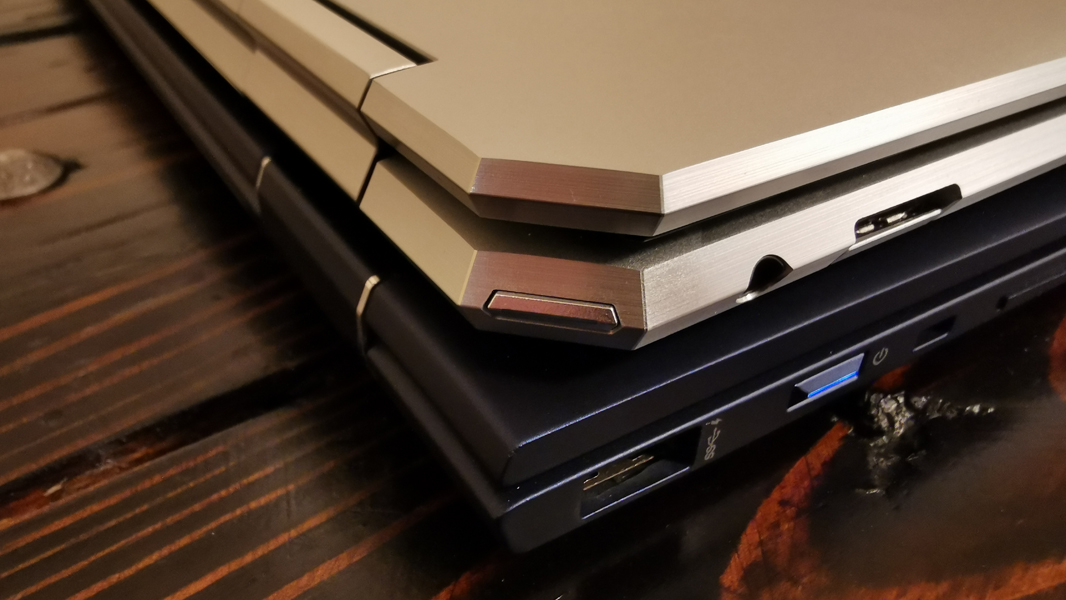
By comparison, the Dragonfly’s rear-most USB-C port shares a problem with other EliteBooks: Its position ensures that the power (or other) cable will always be in the way if you need to use a mouse on the right side of the PC. It’s a rare ding for an otherwise stellar design.
Speaking of ports, HP went in very different directions on each of these PCs.
Like other EliteBooks, the Dragonfly provides a useful combination of new and legacy ports, keeping dongles to a minimum. You get a full-sized USB 3.1 port, a full-sized HDMI port, a nano-SIM card tray for 4G LTE capabilities, and two Thunderbolt 3/USB-C ports, both of which are on the right. I’d prefer to see one of those latter ports on each side of the PC, and as far back as possible.

The Spectre also ships with two Thunderbolt 3/USB-C ports, one of which, again, is nicely angled out at a 45-degree angle from the right rear of the PC. It also has a single full-sized USB 3.1 port, which requires a “garage door”-type cover because of the thinness of the PC, and a microSD card slot.
The keyboards on each PC are completely different internally and externally, but they both provide a very similar key feel and identical 1.3 mm key throws. The Dragonfly uses a completely new design that is quieter and lighter. But the Spectre keyboard is also excellent and quiet.

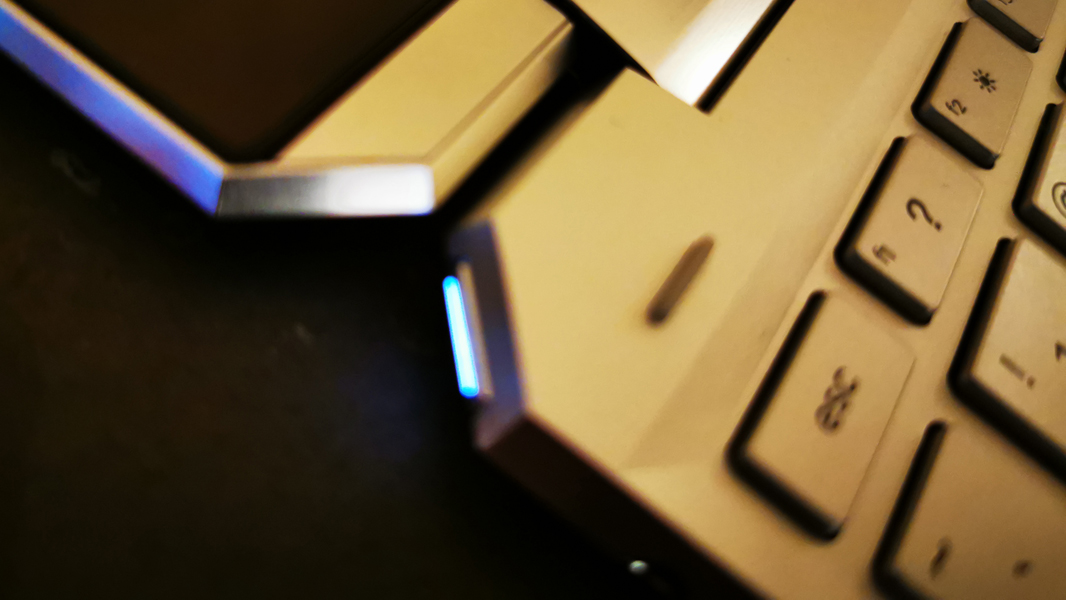
The layouts are surprisingly quite different, with the Dragonfly adopting an EliteBook-like layout with collaboration keys and a new Fn lock function built-in to the left Shift key, which I like. But its arrow keys, like those on other EliteBooks, are smaller and harder to use as well.
The Spectre has the preferred layout overall, however. The Home, Pg Up, Pg Down, and End keys get a dedicated column on the right, which I prefer, rather than buried under Fn key/arrow key pairings. The Spectre also offers a microphone mute key, a first, and a dedicated hardware switch on the right side of the PC for toggling the webcam shade for privacy. Those functions are not available on the Dragonfly.

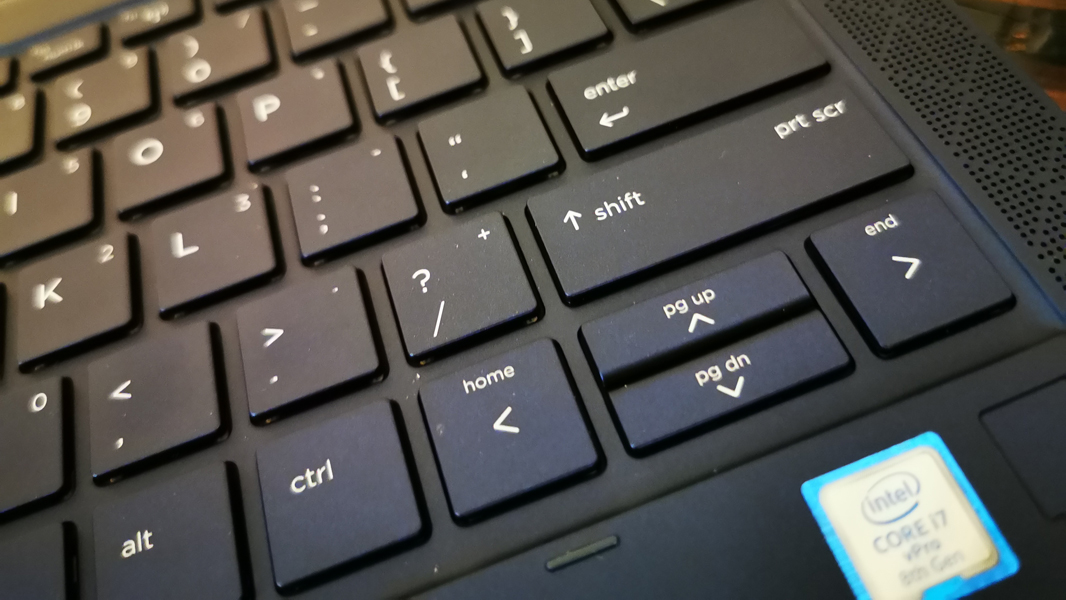
The glass touchpads are of similar quality, but the Dragonfly’s is bigger/taller thanks to this PC’s slightly larger wrist rest area. I don’t mind the shorter Spectre touchpad, but the size difference is striking. The fingerprint reader on each is, if not literally identical, then identical in use, performance, and reliability.
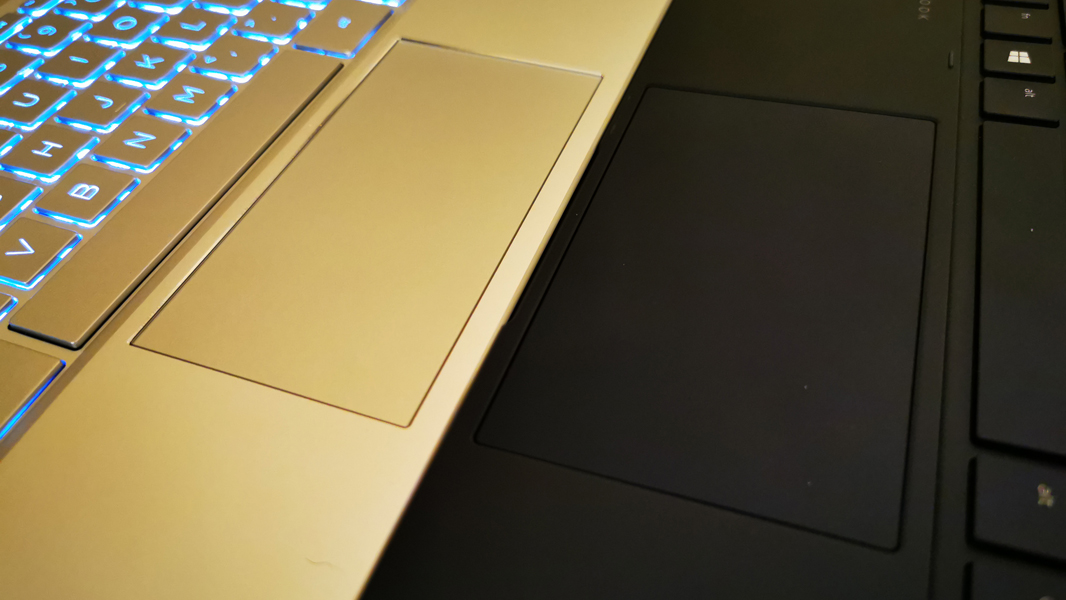
You wouldn’t necessarily expect this in a business laptop, but the Dragonfly offers surprisingly solid sound thanks to its four speakers (two are top-firing, two are bottom-firing) and four discrete smart amplifiers. The environmentally-conscious will also like that the Dragonfly’s speakers are made largely from recycled plastic, including some ocean-bound plastic material.
The Spectre, by comparison, offers decent sound as well, but because of the form factor size reduction with this generation, its two speakers are only bottom-firing. As a result, the Spectre sounds notably better if it is sitting on a hard surface.
Internally, the two PCs offer surprisingly different components. The Dragonfly provides 8th-generation Intel Core i5 and i7 processors, whereas the Spectre uses newer 10th-generation parts. But these U-series processor options aren’t as different as they sound; both are quad-core designs and the performance and battery differences are minimal. That said, the Spectre does provide Intel Iris Plus graphics vs. Intel UHD integrated graphics on the Dragonfly, and while that won’t magically transform the PC into a gaming rig, you could see some minor graphical performance improvements.
Both can be had with 8 to 16 GB of RAM, which is typical for these classes of devices. Both likewise can be configured with a wide range of mostly M.2 NVMe-based SSD storage. But HP is also offering Intel Optane configurations on both, which I believe pair slower SSD storage with fast cache to achieve similar performance at lower prices.
Both offer very modern connectivity, including both Wi-Fi 6 and gigabit-class 4G LTE, and you can use both connectivity options simultaneously if desired.
The display options for both PCs appear to be identical. HP offers three choices: A 400 nit Full HD (1920 x 1080) panel that emits just 1-watt of power for optimal battery life, a 550 nit 4K/UHD (3840 x 2160) HDR 400 panel, and an HP Sure View Gen 3 option that is basically a 1000 nit version of the Full HD panel but with integrated (and excellent) privacy filter functionality. They are all multi-touch and smartpen-enabled (and the Spectre comes with the basic HP Pen).

Battery life appears to be impressive on both PCs, but note you can make choices that dramatically alter your experience. The Dragonfly is particularly interesting because it offers two different battery choices, a 38 Wh dual-cell version that is ultra-light and a 56.2 Wh quad-cell version that, to me, is still quite light and dramatically improves longevity. Both PCs can be configured with a low-power 1-watt Full HD display that will also improve the battery life, or with 4K/UHD HDR or HP Sure View Gen 3 option that will cause battery life to take a hit.
It’s nice to have choices, but here’s how it boils down on paper (which we’ll have to go with until I can test battery life in the real-world). Note that the results are sometimes not directly comparable.
The lighter weight Dragonfly delivers up to 16.5 hours of battery life, HP says, while the one with the bigger battery can last up to 24.5 hours (using the MobileMark 2014 benchmark, which mimics real-world usage). HP also reports that the Dragonfly (presumably the one with the better battery and the 1-watt display) can survive for over 15 hours in video playback tests.
HP says that the Spectre x360 13 offers “the world’s longest battery life in a 13-inch quad-core consumer convertible.” It delivers up to 22 hours of battery life, or over 20 hours in video playback tests using headphones. (It delivers 14.3 hours in video playback tests using the speakers.) It apparently delivers 11.8 hours of battery life in web browsing-based tests.
Both PCs also support fast charging, of course. The Dragonfly can gain over 7 hours of battery life with 30 minutes of charging, HP says. The Spectre can charge to 50 percent in just 30 minutes.

From a software perspective, both PCs come with a surprisingly long list of additional applications. Some of this is clearly crapware, but the business-focused Dragonfly provides several system management utilities that go above and beyond the capabilities in Windows, and many businesses will find those useful. (It’s likely that most individuals would find them superfluous and even annoying.) Still, neither provides what I’d call a minimalist software loadout.
The Dragonfly’s management and system utilities include HP Client Security, HP Power Manager, HP Privacy Settings, HP Smart, HP Support Assistant, HP Sure Click, HP Sure Sense, HP System Information, HP WorkWell, and others. There are also several Intel utilities, for some reason, like Intel Management and Security Status, Intel Graphics Control Panel, and Intel Optane Memory and Storage Management.
The Spectre comes with an HP Command Center utility that lets the user configure system performance, fan noise, and temperature using three easily-understood presets: Performance mode, Comfort mode, and Quiet mode. It also provides a Network Booster function that lets you prioritize certain apps or configure the Wi-Fi and LTE for simultaneous use. And there are numerous other HP utilities, like HP Audio Switch, HP Impreza Pen, HP Pen Control, HP Support Assistant, and many more. Even less usefully, the Spectre ships with a 30-day time-limited version of ExpressVPN and the free version of LastPass.
You’ve probably run out of fingers by now, but the bigger comparison point, perhaps, is price, and it is here that the two HPs are as far apart as can be. The Dragonfly starts at about $1550 and you could easily spend over $2000 on a version with a Core i7 processor, 16 GB of RAM, and a big SSD. The Spectre costs $1100 and up, and the upper-level models top out below $2000. If money was no object, the Dragonfly would be my clear choice. But you could save several hundred dollars by going with the premium consumer product.
More soon.
Tagged with
Conversation 23 comments
-
huynh995
<p>A beautiful design. Seems very <a href="https://internetcloning.com/" target="_blank">convenient</a>.</p>